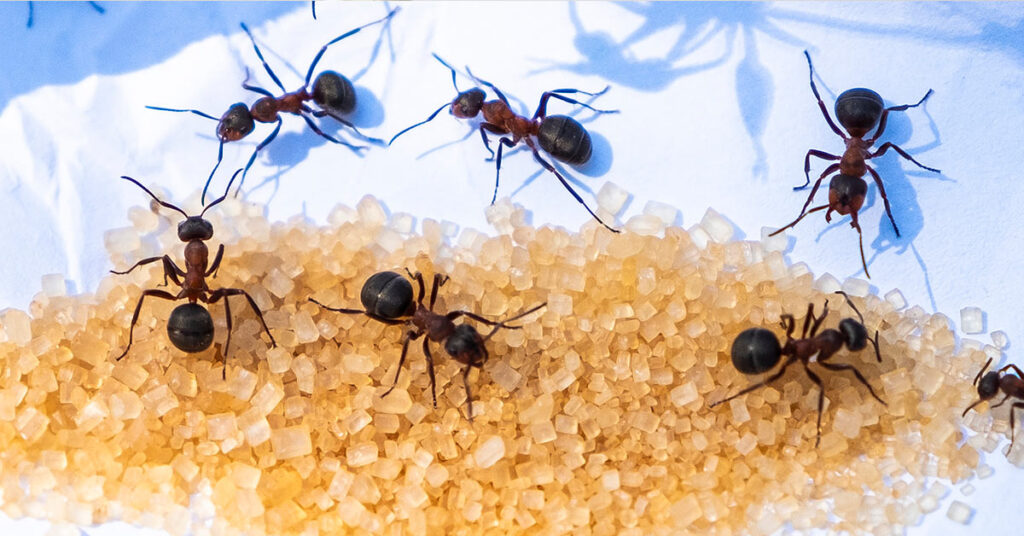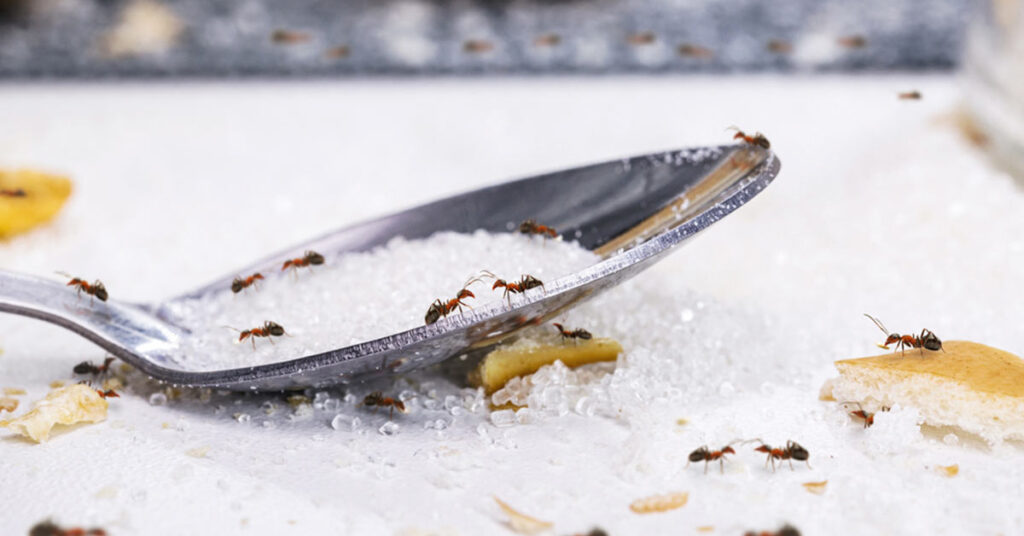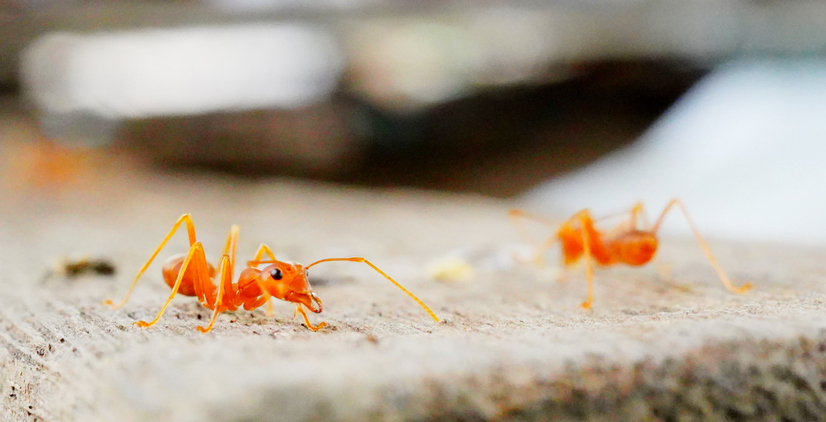Sugar ants can be a nuisance when they invade our homes and kitchens in search of sweet treats. However, with effective management and prevention strategies, it is possible to control and deter these pesky insects. By understanding their habits, preferences, and utilizing various methods such as home remedies and targeted pesticides, we can successfully manage sugar ant infestations and maintain a pest-free environment. In this article, we will explore the most effective techniques for managing and preventing sugar ant problems, empowering you with the knowledge to keep your home free from these unwelcome guests.

Understanding Sugar Ants: Scientific Identification And Common Habitats
This section explores the scientific identification of sugar ants, including their common characteristics and specific species names. Additionally, it provides insights into the typical size of sugar ants and their prevalent habitats. By gaining a deeper understanding of sugar ants’ scientific aspects and their preferred environments, we can better equip ourselves to identify and manage these tiny but determined insects.
- Understanding Sugar Ants: Scientific Identification And Common Habitats
- Sugar Ants’ Preferences: Diet And Attraction
- Sugar Ant Lifecycle, Reproduction, And Longevity
- Interaction With Humans And The Environment
- Comparing Sugar Ants With Other Species
- Is It True That Sugar Ants Never Sleep?
- Effective Sugar Ant Management: From Home Remedies To Pesticides
- Conclusion
What Are Sugar Ants?
These ants have earned the name “sugar ants” due to their persistent quest for sweet food sources. They are frequently encountered in residential areas, where they infiltrate kitchens and pantries in search of sugary delights. Their keen sense of smell allows them to detect even the faintest traces of sugar, leading them to raid open containers, spills, or unattended food items. The relentless foraging behavior of sugar ants makes them a common nuisance, as they are known to trail along countertops, cupboards, and other areas where food is present. Their affinity for sugar-rich foods, such as syrups, jams, fruits, and sugary snacks, drives them to invade homes in their quest for sustenance. Homeowners often find themselves in a battle with these determined sugar ants, striving to safeguard their food supplies and maintain a pest-free environment.
How Can You Identify Sugar Ants?
Sugar ants can be identified based on several distinguishing characteristics. They generally range in size from 2 to 7 millimeters, with variations depending on the species. Their colors can vary as well, with shades of brown, black, or reddish-brown being common. Sugar ants possess a segmented body with a distinct head, thorax, abdomen, six legs, and antennae, which aid in their sensory perception.
Where Are Sugar Ants Commonly Found?
Sugar ants can be found in a wide range of habitats, both indoors and outdoors. Indoors, they are often discovered in kitchens, pantries, and areas where food is stored or prepared. Outdoors, sugar ants may establish nests in gardens, under rocks, in decaying wood, or in other suitable crevices. These ants are highly adaptable and can thrive in diverse environments, as long as there is a consistent supply of sweet food sources.
Sugar Ants’ Preferences: Diet And Attraction
What Do Sugar Ants Eat?
Sugar ants have a strong preference for sugary substances, but their diet is not limited to just sugar. These ants are opportunistic feeders and can consume a variety of food sources. Apart from sugar, they may also feed on nectar, honeydew produced by aphids or other insects, fruits, syrups, and sweet food scraps. Additionally, sugar ants can scavenge for protein-rich foods such as dead insects, meats, and oily or greasy residues. Their ability to adapt their diet to available food sources contributes to their resilience and successful colonization in diverse environments.
What Attracts Sugar Ants To My Kitchen?
Sugar ants are commonly found in kitchens due to the abundance of food sources available. The presence of exposed or improperly stored sugary items, such as sugar bowls, honey jars, sweet snacks, or spilled syrups, can act as strong attractants. Even the smallest traces of sugar can entice sugar ants, as they possess a remarkable ability to detect and follow scent trails. Crumbs, food residues, and unclean surfaces can also draw sugar ants to your kitchen. Furthermore, leaky faucets, dripping pipes, and moist areas provide a water source that can contribute to their attraction. It is crucial to maintain cleanliness, promptly address spills, seal food containers tightly, and eliminate potential food and water sources to minimize their attraction to your kitchen.
Sugar Ant Lifecycle, Reproduction, And Longevity
What Is The Lifecycle Of A Sugar Ant?
The lifecycle of a sugar ant unfolds over a specific timeline, progressing through four distinct stages. It begins when the queen lays eggs, which typically take around 1 to 2 weeks to hatch. The eggs, small and white, give way to the larval stage, which lasts for approximately 2 to 3 weeks. During this time, the legless larvae rely on the workers to feed them and undergo several molts as they grow. Next comes the pupal stage, lasting for about 1 to 2 weeks, during which the larvae undergo metamorphosis within protective cocoons. Finally, the adult ants emerge, fully developed and ready to take on their roles within the colony. This entire lifecycle process, from egg to adult, spans approximately 4 to 7 weeks, depending on various factors such as species, environmental conditions, and availability of resources.
How Do Sugar Ants Reproduce?
Sugar ants reproduce through a process called mating flight or nuptial flight. During this event, winged reproductive ants, known as alates or swarmers, leave the colony in large numbers. Males and females engage in mid-air mating, after which the males die, and the fertilized females shed their wings and become new queens. The newly mated queens search for a suitable nesting site to establish a new colony. Once settled, the queen begins to lay eggs, and the colony grows from there.
How Many Eggs Can A Sugar Ant Queen Lay In Her Lifetime?
A sugar ant queen has the remarkable ability to lay a significant number of eggs in her lifetime. The exact number can vary depending on the species and environmental factors, but a healthy sugar ant queen can produce thousands of eggs during her lifespan. The queen’s sole purpose is to reproduce and ensure the survival and growth of the colony, so she is capable of continuously laying eggs as long as she is healthy and well-nourished.
How Long Do Sugar Ants Live?
The lifespan of sugar ants can vary depending on their caste within the colony. Worker ants, which perform various tasks such as foraging and nest maintenance, typically live for several weeks to a few months. Their lifespan can be influenced by factors such as environmental conditions, availability of food, and threats from predators. Queens, on the other hand, have significantly longer lifespans. Depending on the species, a sugar ant queen can live for several years or even up to a few decades. They have the ability to continuously lay eggs throughout their lifespan, ensuring the growth and survival of the colony.
Interaction With Humans And The Environment
Understanding how sugar ants behave in relation to humans and their surroundings can help us better manage their presence and appreciate their role in the ecosystem. From their interactions with humans, potential harm or nuisance, to their ecological significance and natural predators, exploring the dynamics of sugar ants in their interactions with both humans and the environment provides valuable insights into coexistence and effective pest management practices.
Do Sugar Ants Bite Or Sting?
Sugar ants are not known for their aggressive biting or stinging behavior. While they have mandibles and can bite, their bites are usually mild and rarely cause significant pain or harm to humans. They are more likely to bite when they feel threatened or if their nest is disturbed. However, their bites are typically harmless and do not result in any long-term health effects.
Are Sugar Ants Harmful To Humans?
In general, sugar ants are not considered harmful to humans. They do not transmit diseases directly, nor do they pose any serious health risks. However, their presence can be a nuisance, especially when they invade homes and contaminate food sources. Additionally, some individuals may experience minor skin irritations or allergic reactions in response to ant bites.
Do Sugar Ants Cause Damage To Homes Or Buildings?
Sugar ants are not known to cause significant structural damage to homes or buildings. However, their foraging behavior can lead to issues such as food contamination and the attraction of other pests. They are attracted to sugary substances and can infest pantries, kitchens, and areas where food is stored. It is important to address ant infestations promptly to prevent any potential damage or hygiene concerns.
Can Sugar Ants Infest Furniture Or Other Household Items?
While sugar ants primarily focus on foraging for food sources, they can explore and infest various areas of a home, including furniture and household items. They are particularly drawn to sugary spills, crumbs, and food residues. It is essential to maintain cleanliness and promptly address any spills or food debris to discourage sugar ants from establishing colonies in unwanted areas.
What Role Do Sugar Ants Play In The Ecosystem?
Sugar ants, like other ant species, play important roles in the ecosystem. They contribute to soil aeration and nutrient cycling, helping to improve soil health. Sugar ants also serve as scavengers, cleaning up organic debris and dead insects. Additionally, they serve as a food source for other organisms, such as birds, reptiles, and other predatory insects.
What Are The Natural Predators Of Sugar Ants?
Sugar ants have several natural predators that help control their populations. These include various insect predators such as spiders, beetles, and predatory ants. In addition, some bird species, such as woodpeckers and sparrows, feed on ants. These natural predators play a crucial role in maintaining the balance of ant populations in the environment.
Comparing Sugar Ants With Other Species
When comparing sugar ants with other species of ants, it becomes evident that each species has its own unique characteristics and behaviors. One common comparison is between sugar ants and carpenter ants. While both are attracted to sweet substances, they differ in their nesting preferences and structural impact. Sugar ants typically build their nests underground or in decaying wood, focusing on finding food sources in residential areas. In contrast, carpenter ants excavate galleries in wood, potentially causing structural damage to buildings and wooden structures. Another comparison can be made between sugar ants and pavement ants. While both species are attracted to sugary foods, pavement ants are known for their preference for nesting in pavement cracks, sidewalks, and driveways. They are often seen forming trails near food sources in outdoor environments. Understanding these distinctions between sugar ants and other ant species is crucial in implementing appropriate pest control measures tailored to their specific behaviors and habitats.
What Is The Difference Between Sugar Ants And Fire Ants?
Sugar ants and fire ants are two distinct species of ants with notable differences in behavior, habitat, and physical characteristics. One of the primary differences lies in their nesting habits. Sugar ants typically build their nests underground or in decaying wood, while fire ants construct large mound-shaped nests on the ground.
In terms of appearance, sugar ants are generally smaller in size, ranging from 1/16 to 1/8 inch in length, while fire ants are slightly larger, measuring about 1/8 to 1/4 inch. Fire ants are known for their reddish-brown coloration, whereas sugar ants can vary in color, ranging from light brown to black.
Another significant distinction is their aggressiveness and defensive behaviors. Fire ants are notorious for their aggressive nature and ability to deliver painful stings when they feel threatened. Their stings can cause burning sensations, and intense itching, and may even lead to allergic reactions in some individuals. On the other hand, sugar ants are not known for their stinging capabilities and are generally considered less aggressive.
In terms of diet, both sugar ants and fire ants are attracted to sweet substances, but fire ants have a broader diet and are known to consume a wide range of food, including plant material, insects, and even small animals. Sugar ants primarily focus on sugary foods and are commonly found foraging near food sources in residential areas.
While both species can be considered household pests when they invade homes, fire ants are generally perceived as more troublesome due to their painful stings and potential for larger colonies. Sugar ants, although they can be a nuisance, are typically less aggressive and their colonies are smaller in size.
Is It True That Sugar Ants Never Sleep?
Contrary to popular belief, sugar ants do require periods of rest and sleep. While they may not sleep in the same way as mammals, sugar ants have intermittent periods of rest known as “power naps.” These short bouts of rest allow the ants to conserve energy and recover from their activities. During these rest periods, sugar ants may appear less active or motionless, but they are still capable of responding to stimuli and performing necessary tasks within the colony. The sleep patterns of sugar ants are regulated by their biological clocks and can vary depending on the species and colony’s needs. Understanding the unique sleep behavior of sugar ants adds to the fascinating characteristics of these creatures and highlights the diverse sleep patterns found in the animal kingdom.
Effective Sugar Ant Management: From Home Remedies To Pesticides
Dealing with sugar ants in your home can be a common nuisance, but there are effective strategies to manage and eliminate them. Here are some methods to consider:
How Can I Get Rid Of Sugar Ants In My Home?
To get rid of sugar ants, it is important to target their colonies and eliminate their food sources. Start by practicing good sanitation in your home, ensuring that all food and sugary substances are properly stored in airtight containers. Clean up spills promptly and keep countertops, floors, and other surfaces free of food debris. Seal any entry points where ants may be accessing your home, such as gaps in windows, doors, or cracks in the foundation. Additionally, removing any outdoor debris or vegetation that can serve as nesting sites can help reduce ant populations.
Are There Any Home Remedies To Get Rid Of Sugar Ants?
Yes, there are several home remedies that can be effective in deterring and repelling sugar ants. One commonly used remedy is using a mixture of vinegar and water. The strong scent of vinegar disrupts the ants’ trails and makes them less likely to enter your home. Simply mix equal parts of vinegar and water in a spray bottle and apply it along ant trails, entry points, and areas where they are commonly found. Other natural remedies include using lemon juice, cinnamon, peppermint oil, or bay leaves, as these scents are known to repel ants.
Another option is to use cinnamon, as sugar ants dislike its strong scent. You can sprinkle cinnamon powder near entry points, along ant trails, or in areas where they are commonly seen. Another effective remedy is peppermint oil, which can be mixed with water in a spray bottle and applied around ant-infested areas. Lemon juice, with its acidic nature, can disrupt ant trails and deter them from entering your home. Simply squeeze fresh lemon juice and wipe it on surfaces or create a lemon juice and water solution to spray around infested areas. Bay leaves, when placed near ant entry points or crushed slightly, release a scent that repels sugar ants. Scattering used coffee grounds or creating a mixture of baking soda and powdered sugar can also deter ants. While these remedies can be helpful, they may not eliminate the entire ant colony. For severe infestations or persistent problems, professional pest control assistance or targeted pesticides may be necessary.
What Are The Effective Pesticides For Sugar Ants?
If the infestation persists or becomes severe, the use of pesticides may be necessary. There are various effective pesticides available specifically formulated for sugar ants. It is crucial to select a pesticide that is labeled for use against sugar ants and follow the instructions carefully. Here are some brands to try:
Terro Liquid Ant Baits
Terro is a well-known brand that offers effective ant baits. Their liquid ant baits contain a sweet liquid that attracts sugar ants. The ants consume the bait and carry it back to their colony, effectively eliminating the entire colony.
Advion Ant Gel Bait
Advion is another popular brand that provides effective ant control solutions. Their ant gel bait is designed to attract and kill sugar ants. The gel is applied in areas where ants are active, and the ants feed on it, leading to colony elimination.
Raid Ant & Roach Killer
Raid is a trusted brand known for its insect control products. Their Ant & Roach Killer spray can be used to directly target sugar ants and kill them on contact. It provides quick knockdown and residual control, helping to manage ant infestations.
Ortho Home Defense Ant & Roach Killer
Ortho Home Defense offers a range of products for pest control. Their Ant & Roach Killer spray is effective against sugar ants, providing fast-acting and long-lasting control. It can be applied to infested areas or sprayed along ant trails.
Combat Max Ant Killing Gel
Combat Max is a brand that offers ant killing gel products. Their ant killing gel bait is designed to attract and kill sugar ants. The gel is applied in areas where ants are active, and it works to eliminate the entire ant colony.
Conclusion
Understanding their habits, preferences, and characteristics can help us effectively manage and prevent infestations. By implementing preventive measures, such as maintaining cleanliness, sealing entry points, and eliminating food sources, we can minimize the presence of sugar ants in our homes. A combination of home remedies and targeted pesticides can be employed to control infestations if they occur. It is important to address sugar ant problems promptly to prevent damage to property and ensure a comfortable living environment. Remember, if the infestation persists or becomes overwhelming, seeking professional assistance from pest control experts is recommended to ensure long-term management and peace of mind.




